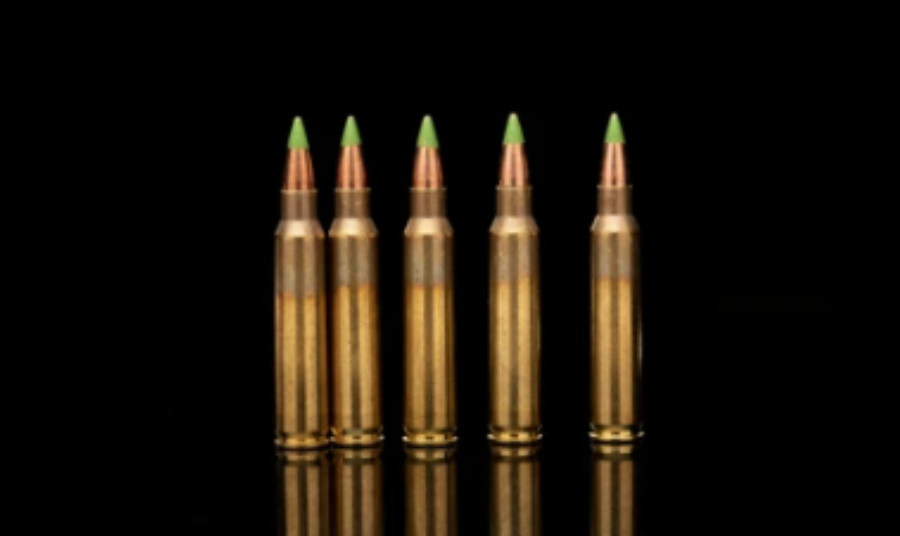Green tip ammo, officially known as the 62gr M855 round, has long been associated with speculation about its ability to pierce body armor. However, that’s far from the truth, and the shooters of today would do well to disregard the hearsay and misconceptions that have unfairly tarnished its reputation as a round too dangerous for civilian use.
The M855 green tip features a steel tip over a tungsten-composite or lead core, encased in a full copper jacket. While it is true that this round can penetrate a steel helmet at 800 yards, it is essential to clarify that it is not classified as an armor-piercing round by the ATF.
Originally designed with the intention of enhanced penetration compared to standard FMJ rounds, the M855 green tip has been criticized as a "big bad body armor breaker." Yet, recent tests have shown that this reputation is not entirely warranted. In fact, it failed to penetrate a BulletSafe Level IV vest during rigorous testing, demonstrating its limitations against modern body armor.
For hunters, the green tip is unsuitable due to its lack of expansion, causing minimal tissue damage and limited blood loss in animals. Similarly, for self-defense purposes, its tendency to over penetrate makes it less than ideal for close-quarters encounters. Additionally, the 1-in-9 inch twist rate might reduce its performance in short-barreled weapons.
However, it is crucial to understand the original purpose behind the design of the M855 round. Invented in the 1970s and initially designated as the SS109, it was primarily focused on flight stability and penetration of light barriers, such as wood, glass, sheet metal, and heavy clothing. The development of body armor-penetrating rounds was not a priority at the time, as the first SAPI plates capable of stopping rifle fire only became available in the early 2000s.
Despite the green tip's limitations and lack of true armor-piercing capabilities, it has faced unwarranted fear and scrutiny. In 2015, the ATF attempted to reclassify the round as armor-piercing, sparking nationwide concern among gun owners. However, passionate responses from responsible firearm enthusiasts highlighted the inaccuracies of such claims and the potential infringement on Second Amendment rights, leading the ATF to withdraw their proposal.
Apart from the armor-piercing debate, there are other reasons why certain firing ranges prohibit the use of green tip ammo. It has been observed that prolonged use of this ammunition on steel targets can gradually degrade the steel, making it thinner with each hit. Additionally, the steel jacket of the M855 can produce sparks upon impact, posing a fire hazard.
If green tipped ammo is no good for piercing armor, can’t be shot at the range, and can’t be used for hunting, then what is it good for?
Long ranged shooting. That is, as long ranged as a 5.56x45mm can go. An M855 has impressive ballistics thanks to its steel core and is more accurate than a standard FMJ at ranges up to 800 yards. It also maintains supersonic flight until the same range, while ordinary FMJ rounds begin to lose supersonic velocity after around 650 yards of travel. A green tip’s round also tends to have less drop, giving it a flatter and thus more accurate trajectory.
While many state that green tip ammo is great because it’s military-issue, NATO militaries use the M855 ammo not only because of its impressive accuracy but because their hands are bound by the Hague convention on expanding ammo. The 1899 Hague Declaration stated:
“The Contracting Parties agree to abstain from the use of bullets which expand or flatten easily in the human body, such as bullets with a hard envelope which does not entirely cover the core or is pierced with incisions.”
This means, in essence, that the average civilian who is unbound by the articles of the Hague can purchase better, more destructive ammo for self-defense rather than rely on what the governments of NATO give to its soldiers.
While it is evident that green tip ammo is not the ultimate armor-piercing round as believed by some, it does find its niche in long-range shooting. With impressive ballistics and increased accuracy compared to standard FMJ rounds at extended ranges, it caters to the needs of precision shooters looking to engage targets up to 800 yards away.
In conclusion, the M855 green tip ammo's negative reputation as an illegal bullet is undeserved, as it is not officially classified as armor-piercing by the ATF. Its limitations in hunting, self-defense, and close-quarters scenarios are apparent, but its strengths lie in long-range target practice. By understanding the true capabilities of this ammunition, hunters and shooters can make informed decisions based on facts rather than misconceptions.


3 comments
Joshua
Its (light) armour piercing for penetrating vehicle doors, drywall,wood fences,objects that stop deform go zing or plop are hp, lead and copper. Steel will keep form velocity and terminal coefencancy through barriers.
Paul
It is true that all major powers signed onto the Hague Conference, with one exception. The USA was never a signer of that part of Hague convention, the use of soft tipped ammunition. Hollow points are legal for use by the US military and, in fact, M1153 9mm hollow points are in current use.
Kw
What’s the ballistic of the 855fron 20"barrel